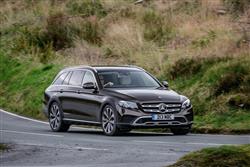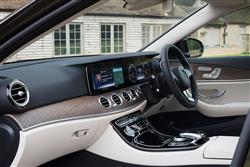PLUSH IN THE SLUSH (some text hidden) --NONE--
By Jonathan Crouch
Introductionword count: 31
With the E-Class All-Terrain, sold between 2017 and 2019, Mercedes aimed to offer a compelling option in the market segment for large, luxurious executive estates with 4WD capability and SUV-style looks.
Modelsword count: 5
5dr Estate (3.0 diesel [E350d])
Historyword count: 456
Here's a Mercedes E-Class Estate you might want to get muddy. Yes really. With this E-Class All-Terrain, launched in 2017, the company finally entered the market segment for executive estates with 4WD capability and SUV-style looks. There's not really any social stigma in driving a conventional SUV these days, but nor for many buyers is there any real reason to do so. Here, in principle at least, was a more sensible option that gave its customers most of same kind of capability and versatility but with subtler packaging. Mercedes usually isn't slow to enter new market niches, but there are exceptions to that rule. For example, the brand couldn't offer you any sort of mid-sized SUV until their GLC model was launched in the Spring of 2016. And, for people buying in that car's segment who needed light off road capability but didn't want an SUV, the company had never, prior to 2017, provided a contender to take on Audi's A6 allroad, a model that by the time of this Mercedes' launch had been in production since the turn of the century and had since been specifically taken on only by a series of large Volvos. This E-Class All-Terrain finally filled that niche, offering its Audi rival more direct competition with more of the prestige and badge credibility that likely wealthy buyers in this narrow market segment wanted. You have to wonder though, why it took Mercedes so long to make it, this model launched here late in 2017, 18 years after the original version of the A6 allroad. It wasn't as if development of this derivative was very taxing for the Stuttgart engineers. Virtually all of the elements needed to create it were already available from various parts of the standard E-Class Estate line-up - primarily of course, the 4MATIC permanent 4WD system. To be specific, only 5% of the parts used to create this All-Terrain variant were different from those of a standard all-wheel drive E-Class estate. But of course that doesn't tell the whole story. The 4MATIC system on an ordinary 'W213'-series E-Class was designed merely for extra tarmac traction. Here, mated to more capable tyres and higher ride height settings on the standard AIR BODY CONTROL air suspension, it could offer this car proper capability on the kind of rocky forest track to your weekend country cottage that would either defeat or damage an ordinary executive estate. Plus this All-Terrain model is a prodigious tower and it'll feel a really clever choice in a snowy snap. In short, this is, as one writer observed, the automotive equivalent of a GoreTex jacket over a business suit. It sold only until 2019 and wasn't replaced when Mercedes facelifted the 'W213'-series E-Class range in 2020.
What You Getword count: 379
The aesthetic changes made to create this rough road-orientated E-Class variant are mercifully subtle. And appropriate. After all, you'll probably be buying this car because you don't want an SUV. The changes that have been made are most evident at the front, where the twin-finned front grille has broader vented central spokes more like those you'll see on the brand's GLA and GLC crossover models. From the side, the differences over any standard well-equipped E-Class Estate model are limited to the black plastic trimming used around the wheel arches and a lower side skirt highlighted by a chromed strip. Inside, the cabin is pretty much as it would be in any other well-specified E-Class Estate, features unique to this variant restricted to floor mats with 'All-Terrain' lettering and the rather bright 'light carbon grain' aluminium trim that's used across the dash and into the doors. Some original buyers preferred the alternative 'black open-pore ash wood' or 'metal weave' finishes as an alternative. Standard for All-Terrain buyers is the 'COMMAND Online' centre dash infotainment system with its classy 12.3-inch monitor. Also included is a virtual instrument binnacle display of the same size, creating one huge 'floating'-style screen that flows right across the dash and is framed by subtle ambient lighting. In the rear, the first thing you find is more than ample space. If the front passengers have their seats at the lowest setting, you might find room for your feet slightly limited, but otherwise the rear footwells are big and broad. The boot features a powered tailgate. The hatch raises to reveal the largest luggage area in the class, rated at 640-litres. To give you some perspective on that, rival Audi and Volvo models can offer only 565-litres and 560-litres respectively. Small wonder that Mercedes was the only brand in this segment able to offer the option of a couple of extra boot-mounted chairs, though for some reason, this 'All-Terrain' variant couldn't be fitted with that option. If you're able to flatten the main parts of the back seat, you'll do it via the neat buttons you'll find on either side of the cargo sidewalls (and you'll find further ones just inside the rear doors). Once you've activated these, a capacity of up to 1,820-litres can be freed up.
To see the full road test text contact us on 0330 0020 227
Pictures (high res disabled)
.jpg)
.jpg)
|
.jpg)
|
.jpg)
| |||
.jpg)
|
.jpg)
|

| |||
.jpg)
|
.jpg)
|

|
Scoring (subset of scores)
Category: Luxury Saloons and Estates
| Performance | |
| Handling | |
| Comfort | |
| Space | |
| Styling, Build, Value, Equipment, Depreciation, Handling, Insurance and Total scores are available with our full data feed. | |



